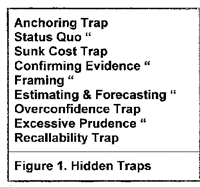Except for natural disasters such as earthquakes, floods, or hurricanes, all risks are man-made. This article is a synthesis of three past Harvard Business Review articles. The bibliography is at the end of the piece. Project Managers (PMs) usually have very little control of the risk circumstances in which they are placed. Taken together, viewing risk from the combined perspectives of the authors cited should help PMs assess risk in their own environments. Summarizing the titles as follows: “Right Risks,” “Is it Real?” and “Hidden Traps” will help us consider the contribution of each, and then meld them into the PM’s decision process.
The Right Risks
This story is the easiest to test and to tell. An example is for a hospital. It’s not all that useful to put manage-ment energy into Food Service or Laundry. Having better peas and carrots is not a conscious choice of most patients seeking care. There is no leverage for a hospital to have the best laundry or restaurant service in an area. These activities are almost always outsourced to companies that specialize in these routine functions. Competencies and competition are better placed in Cardiology, Emergency Room or Pediatrics which offer higher value. Other businesses also have similar initiative choices to consider, where the revenue contribution to the mission, reputation, or goals of business projects needs to be evaluated. Whether his/her current project meets this criterion is for the alert PM to ponder.
Is it Real? Can We Win?
The author of this article presents the Probability- Impact matrix in a somewhat different way. In the business sense, he places “Familiarity with the Industry” on the X-axis, and the “Adroitness with the Technology” on the Y-Axis. The tradeoff is the likelihood of having the technology or opportunity, versus the probability of success. The author introduces modeling of small changes in price or of delivery timing to test whether the right product or service can affect customers positively. Looking at new markets offers both higher payoff and more risk. Of value to PM’s, the author introduces the interplay between achieving success and the likelihood of getting there. Projects should be evaluated on both axes.
Hidden Traps
 There are nine hidden traps of decision-making cited, of which I’ll expand on three of them. Falling into these traps increases risk immeasurably. (See Figure 1)
There are nine hidden traps of decision-making cited, of which I’ll expand on three of them. Falling into these traps increases risk immeasurably. (See Figure 1)
Of all the risks that are situational, the most deadly are those brought on by self-delusional built-in biases. In the “Savings and Loan” bubble of the 1980’s, the “Dot.com” bubble of 2000, the “Housing bubble” of 2006-8, or the “risk-free” operation that Bernie Madoff perpetrated where the investments were imaginary – How could so many people delude themselves so often and so completely?
Of the list, I find the “Confirming Evidence” trap to be the most insidious. All you have to do is call a couple of peers and if you all agree, it must be right, right? At the end of the article, I’ll give an opinion on this. (My opinion must be better than the hundreds of thousands of people who made all the financial mistakes, right?)
The “Status Quo” trap is another good one. In far too many cases, people will rather stick with what they have or know than make the effort to weigh alternatives. The example given is people who keep inherited stock, rather than analyzing and investing money in something they have evaluated. After all, the inherited stock is free, right, so what can you lose?
The “Framing” trap is harder to describe. Two or more similar circumstances will cause different reactions in people depending on how they are presented and perceived. The authors’ example notes that when people are offered a choice of receiving an amount of money, and then are given the opportunity to have a fifty-fifty chance of decreasing it $300 or increasing it $500, in many trials, most persons turn the opportunity down. However, when the choice is framed with a starting point of $2000, and they are told they can either lose back to $1700 or gain to $2500, the same bet in magnitude and favor on the upside, the majority now vote to take the bet. Perhaps the starting dollar amount of $2000 places a boundary around the bet which is lacking otherwise?
This same test was done with a starting point of $30 and the opportunity gain or lose $9. The choice was then presented to other groups, who instead were told they could either end with $21 or $39. The majority of the first groups declined taking the bet, while the majority of the second groups opted to gamble. The only difference was how the tests were framed. Why people behave differently over the framing is not known. The Framing bias almost always gives different valuations for circumstances with exactly the same probability of gain and loss, but differences persist over groups when nothing but the presentation language is changed, not the underlying problem and opportunities.
The values of overconfidence, prudence, estimating biases or other biases also enter into the area where analyzing the possibility of bias can lead to better decisions. We can’t eliminate bias, but in situations of risk, rechecking whether you are thinking correctly, may check your assumptions to help avoid the pitfalls.
Summary
The presence of bias enters into all our decisions. In the case of risk, especially in unique circumstances where there is not a history of repeatable patterns, stopping to record which choices may incur which biases may overcome the group-think that we so easily fall into. My opinion is the classic “If it looks to good, it probably isn’t real” and, “If everyone thinks it is foolproof, it probably isn’t”. We can only hope we can at least examine our biases. Remember when checking with your peers, why would two of you know better by confirming each other’s opinions? Why is the Status Quo better? Make a list and check your assumptions.
You can check some of the materials in the referenced articles by “Googling” author and article. It may not be the full text, but may lead to more useful information on bias and risk.
Long ago, an eighth grade student wrote an eight-word essay on the Fall of Ancient Rome. She said, “The Fall of Rome was due to Carelessness”. We should remain vigilant that we do not cause similar havoc.
– – –
- “Owning the Right Risks”, by Kevin Buehler, Andrew Freeman, and Ron Hulme, Harvard Business Review, September, 2008.
- “Is it Real? Can We Win? Is it Worth Doing? Managing Risk and Reward in an Innovation Portfolio”, by George S. Day, HBR, December, 2007.
- “The Hidden Traps in Decision Making”, by John S. Hammond, Ralph L. Keeney, and Howard Raiffa, HBR, January, 2006.

















